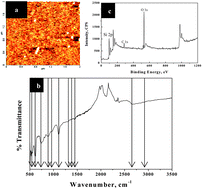Self-assembly of polystyrene-block-poly(4-vinylpyridine) block copolymer on molecularly functionalized silicon substrates: fabrication of inorganic nanostructured etchmask for lithographic use†
Abstract
Block copolymers (BCPs) are seen as a possible cost effective complementary technique to traditional lithography currently used in the semiconductor industry. This unconventional approach has received increased attention in recent years as a process capable of facilitating the ever decreasing device size demanded. Control over microdomain orientation and enhancing long range order are key aspects for the utility of BCPs for future lithographic purposes. This paper provides an efficient route for the fabrication of highly ordered nanostructures suitable for such application. We investigate the significant effect of surface treatment regarding the self-assembly process of polystyrene-block-poly(4-vinylpyridine) (PS-b-P4VP) by employing an ethylene glycol layer, producing well defined perpendicular P4VP cylinders with long range order over large surface areas. Nanopores are generated through surface reconstruction using a preferential solvent, which allows for the incorporation of an inorganic moiety. Treatment of this pattern with UV/Ozone leads to formation of well-ordered iron oxide nanodots with a pitch of ∼26 nm. Furthermore, high aspect ratio silicon nanopillars result following pattern transfer (using Ar/O2).


 Please wait while we load your content...
Please wait while we load your content...